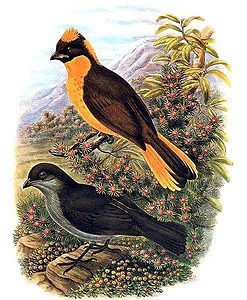A team of international scientists claim that they’ve found evidence of the first non-human species that cultivates planets for non-food purposes. The extremely fine feathered bowerbirds, native to Australia and Papua New Guinea, display an unique courtship behaviour, where males build a home-like structure, called bower, and decorate it with sticks, little stones, and brightly coloured objects in an attempt to attract a mate. The most interesting the bower is, the more chances the male has of attracting a mate.
The bowerbirds’ favorite decorative object, though, is the Solanum ellipticum plant or the potato bush. Surprisingly or not, the team of researchers, comprised of biologists from the Universities of Exeter (UK), Postdam (Germany), Deakin and Queensland (Australia), found a higher density of potato bushes near bowers than anywhere nearby, while trekking through Taunton National Park (Central Queensland).
The first explanation the researchers thought of at first was that the bowerbirds settle their nests in the proximity of potato bush rich areas, however, further investigation showed that these clever birds actually grew their own potato bush – a plant with bright purple flowers and green fruit. Birds with more plants nearby had more berries within their bowers, which the researchers had previously found is the best predictor of a male’s mating success.

After a while the berries shrivel, and the male bowerbird proceeds in discarding the withered fruit, including the afferent seeds, which germinate around the bower. Some bowerbirds have been known to keep the same bower for up to ten years, making it an ideal strategy. What’s most striking about this truly unique gardening behavior is that some sort of genetic manipulation occurred in the bowerbirds’ fruit of preference. Like mentioned earlier, the birds prefer potato bushes because of their fruit’s bright coloring. Plants found nearby bowers were slightly greener in color than those found on other plants, which is the gardeners‘ preferred color.
“Until now, humans have been the only species known to cultivate plants for uses other than food. We grow plants for all kinds of things – from drugs, to clothing, to props that we use in our sexual displays such as roses – but it seems we are not unique in this respect,” noted lead researcher Joah Madden, from Exeter University. “This accumulation of preferred objects close to a site of habitation is arguably the way any cultivation begins. It will be very interesting to see how this mutually-beneficial relationship between bowerbirds and these plants develops.”
You don’t need hands to grow a beautiful garden.
The findings were published in the journal Current Biology.



